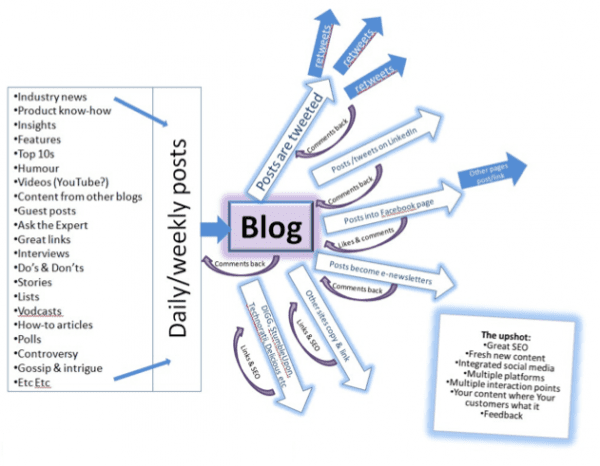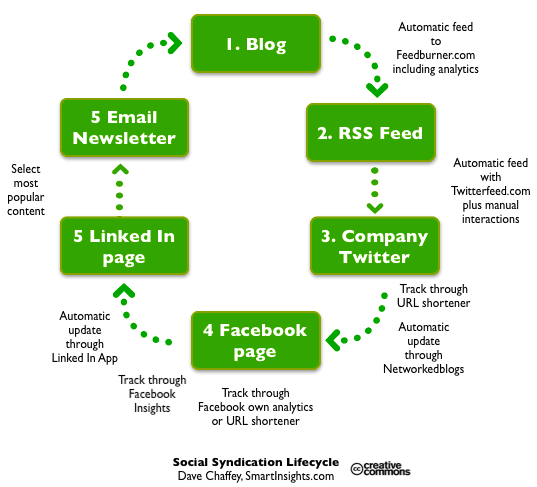Integrating blogging with other communication tools – an integrated approach
Although blogging is far from new, I find that relatively few organisations have really started using blogs effectively. Where they have, they have found a tool that delivers on multiple fronts because it's integrated into all their communications.
When used effectively, the blog is a place for you to develop newsletter content, integrate with other social media tools, showcase your expertise, play with ideas, research a topic and discover customer views. Of course, blogs also yield dividends in terms of SEO as other sites pick up your content giving you invaluable back links, and customers will get on with the job of tweeting and liking your work.
The Blog Central model
Below is a model I’ve developed to use when explaining the concept to colleagues and on my training courses. To make the point of how blogging must be at the heart of your communications, I've called it Blog Central. I think it neatly shows how blogging can drive much of your customer communications activity.

Using the Blog Central model I am able to utilise blogging, e-newsletters and other social media in an integrated manner. For the purpose of this description my business is irrelevant really, but if the context helps you, I sell training DVDs online to church based musicians. I blog most days and every week or so collect the posts together to create a newsletter which is then e-mailed out to my organically grown mailing list.
Syndicating content from your blog
Optimised well, platforms such as WordPress enable content to be rapidly indexed certainly most of my posts are indexed within a few hours, often within minutes. And we know that search engines love fresh keyword relevant content so play the game, write your post and optimise it for search (more on this in a future post). This post by Dave Chaffey shows how different tools can be used to integrate your blog with Twitter, LinkedIn and Facebook using RSS feeds.

In his post, Dave points out its important not to automate everything - personal interactions on the social networks are really important too - don't miss those.
Don't forget to make time for customer research
My more tech-savvy customers receive the blog posts as they happen via RSS feed or Twitter, but most still prefer a less frequent summary newsletter by email – pretty much the same model employed by Smart Insights. As far as frequency is concerned it’s certainly worth researching. We asked my customers what they thought of the frequency and content using the wonderful free online survey tool Survey Monkey. The results were informative, confirming a lot of our assumptions and gratifyingly showed an extraordinarily high satisfaction rate with our communications.
Obviously I know which posts are most popular thanks to Google Analytics tracking as well as the click through rates which I can monitor using my email software (I use Mailchimp). It’s also worth asking customers which type of articles they prefer. Top of the list for my readers is our “Ask the Expert” series. It’s a kind of technical agony aunt for musicians. Knowing how well these were received drove us to really push the concept and we now hold regular online Ask the Expert forums which in their turn drive more blog content (more on that too in a future post).
Seeding your content through social media
Having uploaded a new post I tend to manually tweet each to give it a personal flavour and from there my LinkedIn profile picks up the latest tweets. I’ll also pick the link up in our company Facebook page. You can set many of your social network updates to automatically update on others (Twitter, LinkedIn and Facebook etc) so that updating on one will trigger a cascade of updates on the others. Personally I prefer to do this manually as I adapt the message a little for each platform (demographics can be different and of course you get different character numbers on the different platforms.
As Facebook has grown in popularity we’ve really pushed communicating on that page (you can see it at www.facebook.com/musicademy) and we find a significant number of people prefer to comment on the post on Facebook rather than on the original blog. It’s all good engagement and I’m glad to be putting content on the platforms where customers are most comfortable talking to us and each other. I think people are so used to commenting on their friends’ Facebook status updates that it’s a far smaller jump for them to comment on our updates there than it is to comment on a blog.
All this (as can be seen from the diagram) produces lots of interactions with people. A lot of these are customers - and it’s important to maintain and enhance the relationship with them. It also brings in lots of potential customers many of whom will return again over the weeks learning more about us before considering a purchase.
Integrating the blog with your enewsletter
There are many advantages to using a blog to drive your newsletter content. One is the discipline of writing regularly rather than having to dredge up a load of content at the end of each month. If you’ve written something every few days, you have a ready-made selection of content to use in the next newsletter. If people are subscribing via RSS or something similar you’ll find you already have a good idea on the potential popularity of articles based on current CTR and comments. And if something is really hot then that is the article you lead with in your newsletter.
One tip. Many people dismiss blogs as being about what you had for breakfast. I find this particularly in B2C environments with older customer groups. You may well have to do some educating to get people to understand and accept your blog. On our website, we have two buttons to the blog. One is labelled “blog”, the other “free resources”. I would say that many of our recipients receive our e-newsletter and have no idea that what they click through to is actually a blog. As far as they are concerned it’s just a repository of useful articles. Here’s an example of the way our newsletter looks. You can click through to see any of the articles on the blog.
I plan to pull together a few more articles on blogging in future weeks. If you work in B2B, don't miss Rene Power's excellent series on B2B Blogging. We’ll look at ideas for content, more reasons to blog as well as maximising the SEO potential of your posts.
Is there anything about blogging that you would specifically like me to write? If so please comment below.








